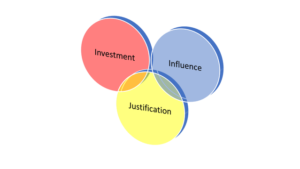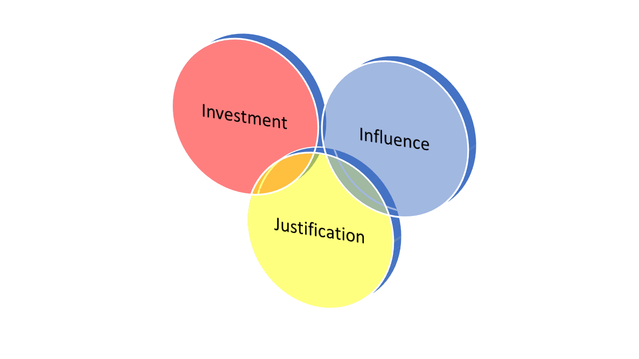
When you try to understand people and explain why they do what they do, what frame do you use? The most common, intuitive (and highly useful) approach is the “belief-desire” frame. That is, people in everyday situations use both beliefs and desires to explain why people do what they do. For example, if we were to observe “Jon” leaving the house to go to the movies, we explain that action by assuming that Jon believes that the movie theater is playing a certain movie and seeing it is something he desires. We can be flexible with this frame. For example, if Jon were a movie critic, then we might presume his belief-desire state for seeing the movie is something different than if Jon were a teenager going to see the movie on a date with his new girlfriend.
Although belief-desire frames are helpful for everyday living, we need a more sophisticated, scientifically grounded frame for deeper understanding. The field of psychology has generated a wide variety of different paradigms, but unfortunately, these paradigms speak different languages and tell us different things about how to understand people. Skinnerian behaviorists claim that we need to get rid of terms like beliefs and desires, and empirically observe the kinds of effects that the environment has on the frequency of emitted behaviors. Cognitive psychologists use the language of information processing to explain beliefs and desires. Freudian theorists claim that conscious beliefs and desires ultimately play a pretty small role in explaining why people do what they do and that the real drivers of human behavior are subconscious forces.
I am developing a more unified language for human psychology and psychotherapy. It takes the key insights from the cognitivist, behaviorists, psychodynamic theorists, and other paradigms (e.g., evolutionary psychology, Russian activity theory) and combines them into a more scientifically coherent (and comprehensive) system. When we look at human behavior via the unified system, three key processes frame our understanding.
The first key process is an investment. The unified approach characterizes human behavior in terms of work effort directed toward effecting change. Whether Jon is headed out because he wants to see the movie, wants to critique the movie for his job, or wants to be with his girlfriend, he’s going to the movie is a form of investment. As suggested by the term investment, work efforts expended (which involve calculations about time, calories, opportunity costs, risks, and so forth) are directed toward particular outcomes. The return might be found in the joy he gets from the movie itself, from the fact that he completes an assignment for his job or a kiss from his girlfriend at the end of it. Framed as such, we can then ask: Where do our tendencies toward investments come from? We are evolved primates, so evolution has primed us to value certain states of affairs (e.g., safety, territory, food, sex, higher social status) over others. In addition, people differ in terms of temperaments and dispositions, much of which is strongly influenced by genetics. Extroverted people find stimulating social situations more rewarding than introverted people. And, of course, one’s learning history directly shapes the investment value system. If Jon loved the first two Star Wars movies, we are not surprised when we hear he has a strong desire to see the third.
The second key process is social influence. As Aristotle noted, we are an incredibly social animal, and one of the most important features of our environment is other people. And our action-investments rarely take place on an island, but they take place in the context of a social matrix. The social influence here refers to two things. First, it refers to the process by which one person’s actions impact the investment of another person. In the current example, it would refer to the way it came about that Jon was going to the movies (did he ask her, she ask him, was there any tension in the process, etc). Important social influence processes involve competition, cooperation, and whether exchanges move people closer (i.e., become more dependent) or make them further apart (become more independent).
The second meaning of influence is as a resource. When considered as a resource, it refers to the capacity to move other people in accordance with our interests. Here it refers to the levels of respect and social value other people show us, the extent to which they listen, care about our well-being and are willing to sacrifice for us. So, if Jon is attracted to his girlfriend and she agrees to go to the movie with him, that is an indicator of social influence as a resource. The harder Jon had to work to get her to go results in raising questions about his social influence. If she breaks up with him, that is a powerful indication of a loss of social influence.
The third core process is justification. In the language of the unified system, “justification” is a broad concept that refers to both the systematic structure and the legitimizing function of verbal communication (including writing). You can think of justification as anything that involves questions and answers which lead to claims about what is and what ought to be. For example, if Jon explains to his girlfriend, “I saw the first two movies in the series and thought they were great,” or says, “I am just happy to be with you, we can see whatever you want,” both are “justifications.” Likewise, if Jon (as a movie critic) gets a call and his editor asks if he has completed the write-up, there is a shared if implicit, justification that Jon needs to do what his boss wants. Arguments, reasons for and against things, rationalizations, laws, and even scientific truth claims all are “justifications” in the unified language system. This blog is a justification for thinking about three core processes that explain why people do what they do.
If you want to achieve a better understanding of why people do what they do, consider starting with these three core processes. Human behavior is first and foremost a kind of “doing” or investing. Individuals do what they do because of either implicit or explicit cost-benefit analyses directed at certain outcomes. Then we can look to the social matrix to see the influence such investments might have on others or how the investment itself might be shaped by social influence factors. Finally, there is the explanatory system that people are using to make sense of the world around them and legitimize what they are doing and why. Keep in mind that even your analysis of the person’s activity in terms of investment, influence, and justification is itself a kind of justification system. These processes line up quite well with common sense belief-desire psychology, and they are grounded in a scientifically unified view of human psychology.

